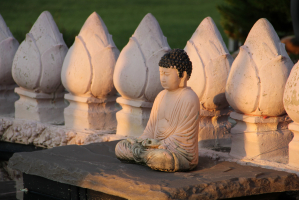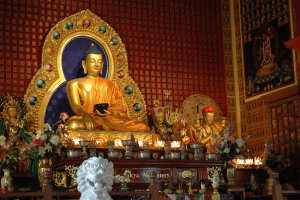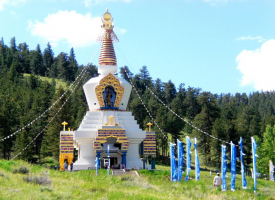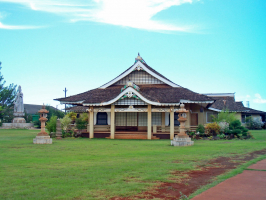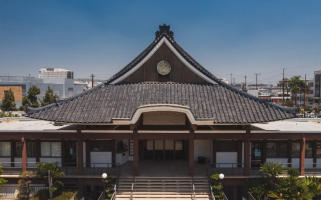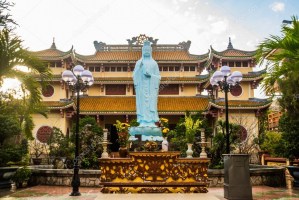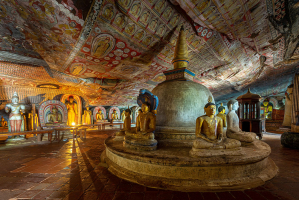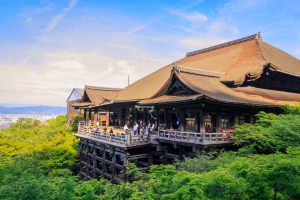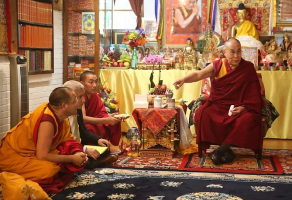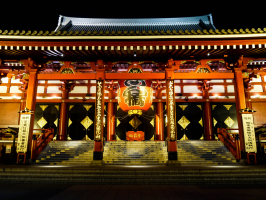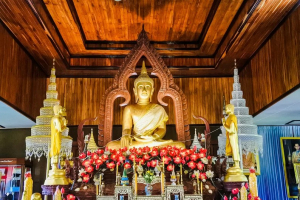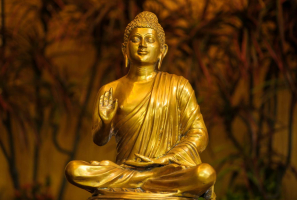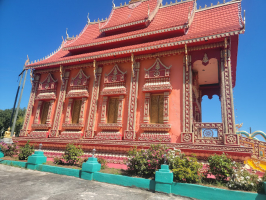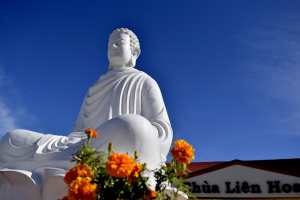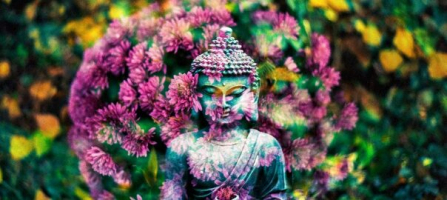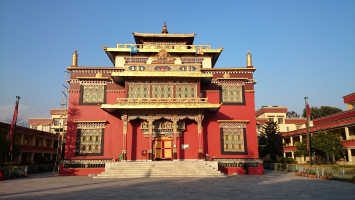Top 9 Most Famous Buddhist Temples in Bhutan
Nestled within the serene landscapes of Bhutan, a land where Buddhism thrives as a way of life, are the top 10 Most Famous Buddhist Temples in Bhutan. These ... read more...spiritual sanctuaries, adorned with vibrant colors and intricate designs, offer a glimpse into the rich religious and cultural heritage of this Himalayan kingdom.
-
Kyichu Lhakhang, a sacred and venerable Buddhist temple in Paro, Bhutan, holds a history that dates back over a thousand years. This ancient temple, one of Bhutan's oldest and most significant religious sites, has a story deeply intertwined with Bhutan's rich cultural and spiritual heritage.
The foundation of Kyichu Lhakhang is attributed to the Tibetan Emperor Songtsen Gampo in the 7th century. According to legend, Songtsen Gampo constructed Kyichu Lhakhang to subdue a giant ogress who was believed to be obstructing the spread of Buddhism in the region. Thus, the temple was built at strategic locations across Tibet and Bhutan, including Kyichu Lhakhang, to pin down the ogress's body.
In Bhutan, Kyichu Lhakhang has further historical significance. It is one of the 108 temples and monasteries built by the Tibetan king Songtsen Gampo in a single day as part of his efforts to spread Buddhism. Over the centuries, the temple underwent several renovations and expansions, with Bhutanese kings and Buddhist masters contributing to its growth and preservation.
The temple's architecture is a testament to Bhutanese craftsmanship. Kyichu Lhakhang features intricate woodwork, mural paintings, and architectural details that reflect the country's distinctive architectural style. The temple is home to important religious artifacts, including statues, scrolls, and revered relics, making it a place of deep spiritual and cultural significance.
Today, Kyichu Lhakhang remains a vital center of Bhutanese religious life and a place of pilgrimage for Buddhists. The temple continues to be an essential part of Bhutan's cultural heritage, and its annual Tshechu (religious festival) draws devotees and tourists alike. Kyichu Lhakhang stands as a living testament to Bhutan's enduring commitment to preserving its rich history and spiritual traditions, providing a profound connection to the nation's past and a source of inspiration for the future.
Address: C9RG+F62, Bhutan
Opening hours: 09:00–12:00–13:00–17:00
Website: https://www.kyichulhakhang.org/
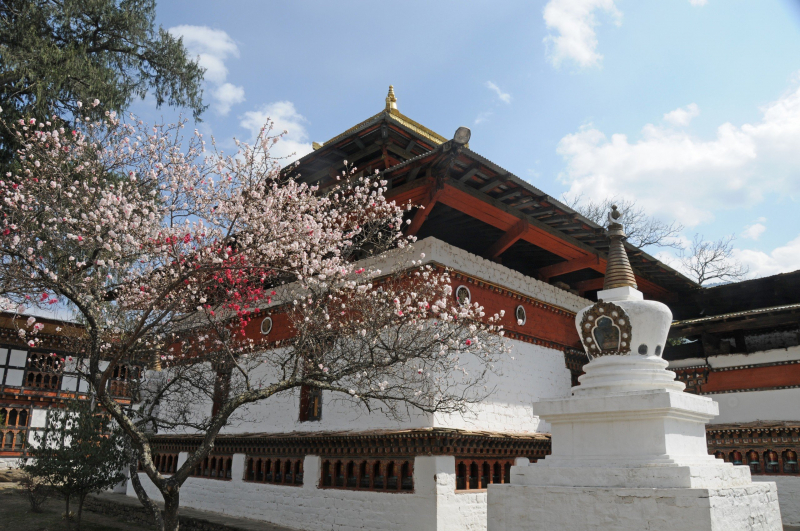
Screenshot of https://commons.wikimedia.org/wiki/File:Kyichu_Lhakhang_temple_Paro_Bhutan_-_panoramio.jpg Video by WildFilmsIndia -
The ancient and highly revered Buddhist temple Jambay Lhakhang is situated in the picturesque kingdom of Bhutan and is particularly dear to the Bhutanese people. Situated in the fertile valleys of Bumthang, it is one of the country's most significant religious and historical landmarks.
The history of Jambay Lhakhang begins in the 7th century, when the Tibetan king Songtsen Gampo is said to have constructed it as one of 108 temples he intended to build in order to defeat an ogre that lived in the Himalayas. The temple is an architectural marvel, showcasing Bhutanese traditional craftsmanship and woodwork.
This sacred temple is known for its rich cultural and religious significance, attracting not only devout pilgrims but also curious travelers from around the world. The surrounding natural beauty of the Bumthang Valley heightens its serene and mystical aura, making it a must-visit location for those looking for spiritual solace and an appreciation of Bhutan's cultural heritage.
One of the most celebrated events at Jambay Lhakhang is the annual Jambay Lhakhang Drup festival. This vibrant and colorful event, which takes place in late October or early November, features masked dances, traditional music, and a fiery naked dance performance known as "Mewang." It draws both locals and tourists, providing an incredible opportunity to witness Bhutanese culture in all its splendor.
Intriguingly, Jambay Lhakhang is home to a unique relic—a sacred relic chorten (stupa) said to contain the ashes of the temple's founder, Songtsen Gampo. The existence of such a relic heightens the spiritual aura of the temple and the Bhutanese people's regard for it.
In sum, Jambay Lhakhang is not just a historical site but a living testament to Bhutan's deep-rooted Buddhist traditions and cultural vibrancy. It invites all who visit to experience the essence of Bhutan, a land where spirituality, history, and natural beauty converge in harmonious unity.
Address: HPGM+4CR, Jakar, Bhutan
Opening hours: 08:00–17:00
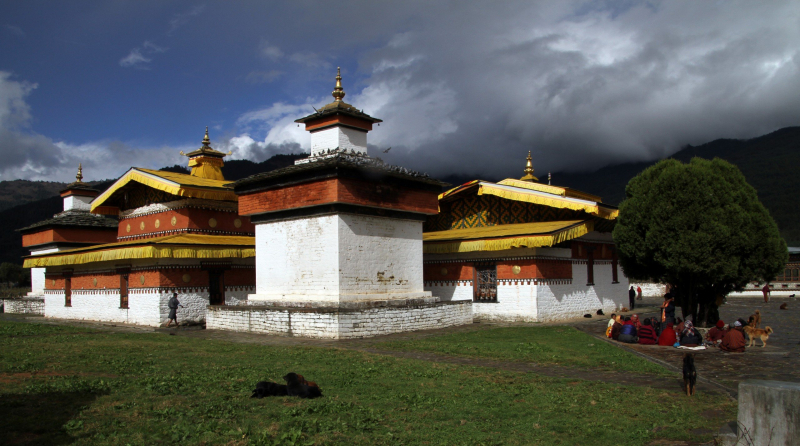
Screenshot of https://commons.wikimedia.org/wiki/File:Bumthang-Jambay_Lhakhang-06-2015-gje.jpg Video by WHITE YAK Productions -
Taktsang Temple is well-known for its exquisite design. Situated atop a precipitous bluff in the Paro Valley, it exemplifies the inventiveness and skill of Bhutanese construction workers. The complex consists of four main temples connected by narrow hallways and steep staircases. With its distinctive style, it highlights Bhutan's rich design history and has grown to become a global tourist destination.
The Taktsang Temple represents the religion and devotion of the people of Bhutan. The temple's history begins in the eighth century, when the father of Bhutanese Buddhism, Guru Rinpoche, is said to have meditated in a nearby cave. This historical and spiritual connection with Guru Rinpoche makes it a place of immense reverence for Bhutanese people and Buddhists worldwide. It serves as a center for religious practices, meditation, and retreats, contributing to the spiritual well-being of the nation.
The temple has played a pivotal role in Bhutan's tourism industry. Taktsang Temple has become an internationally renowned tourist attraction, drawing travelers eager to witness its breathtaking location and spiritual significance. This has not only raised the nation's income but also helped tourists understand Bhutan's history and culture better.
Taktsang Temple has contributed to the preservation of Bhutanese traditions and culture. Celebrations, rituals, and festivals are still performed at the temple, which is still a busy center of religious activity. This ensures that Bhutan's unique customs and beliefs are passed down to future generations, safeguarding the nation's cultural identity.
The temple has a positive impact on Bhutan's economy. The local community benefits financially from the tourism that Taktsang Temple generates by offering services like transportation and guiding. It enhances Bhutanese citizens' quality of life by advancing the economic growth of the nation and the region.
Address: F9Q5+GF Paro, Bhutan
Opening hours: 08:00–13:00–14:00–18:00
Website: https://www.parotaktsang.org/
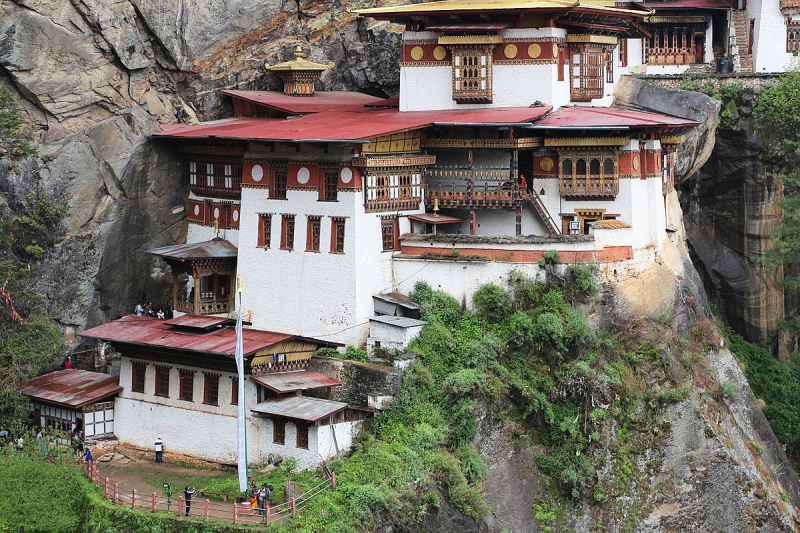
Screenshot of https://commons.wikimedia.org/wiki/File:Taktsang_Monastery,_Bhutan_05.jpg Video by The Planet D -
Holding the 5th position in the top 10 most famous Buddhist temples in Bhutan, Tango Monastery, located in the picturesque Bhutanese town of Thimphu, is a sacred and serene destination that offers visitors a unique glimpse into Bhutan's rich cultural and spiritual heritage. This ancient monastery, perched on a hilltop at an elevation of approximately 2,900 meters, is an essential part of Bhutanese history and religious life.
The approach to Tango Monastery is an adventure in itself, with a scenic drive through winding mountain roads leading to the base of the hill. Visitors can embark on a beautiful hike up the hill to reach the monastery, passing through lush forests filled with rhododendron trees and prayer flags. The hike typically takes around 1-2 hours, and it is both a physical and spiritual journey.
The main temple at Tango Monastery is a striking structure that showcases traditional Bhutanese architecture. It is adorned with intricately painted frescoes, and the interior is a place of peaceful contemplation. The calming sounds of monks chanting prayers frequently greet visitors, fostering a serene environment that encourages introspection.
Tango Monastery is also known as a monastic school where young monks receive their religious education. This means that visitors have a unique opportunity to witness monastic life in action. The monastery's courtyards are adorned with colorful prayer flags, and the surrounding landscape offers breathtaking views of the Thimphu valley, making it an ideal spot for meditation and photography.
The annual Tsechu (festival) at Tango Monastery is a vibrant and lively event where locals gather to celebrate with traditional dances and mask performances. It's a wonderful time to experience the rich Bhutanese culture and join in the festivities.
Tango Monastery is a place of spirituality, natural beauty, and cultural significance. The breathtaking surroundings and magnificent architecture of this tranquil sanctuary, as well as the ongoing customs of Bhutanese monastic life, will captivate visitors. It's a destination that offers a profound and enriching experience for anyone interested in exploring the unique charm of Bhutan.
Address: HJVQ+6FW, Dotanang, Bhutan
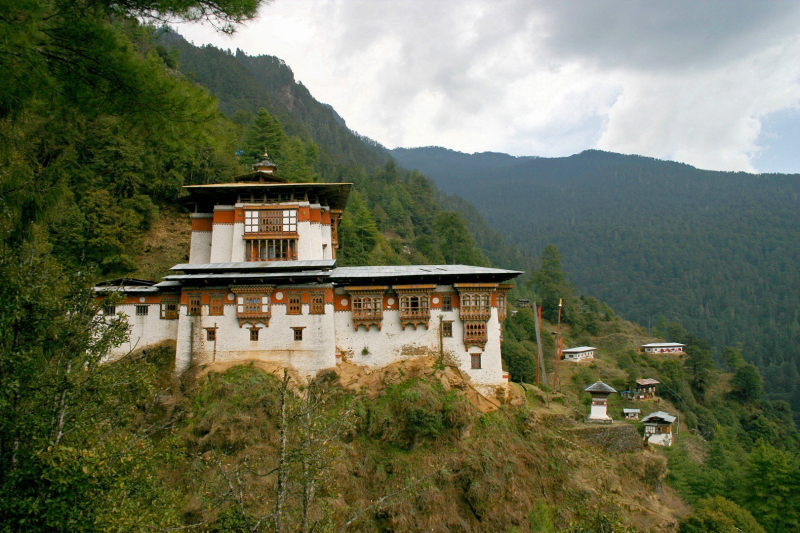
Screenshot of https://commons.wikimedia.org/wiki/File:TangoMonastery.jpg Video by Mostly my Stories -
Kurjey Lhakhang Monastery, nestled in the picturesque Bumthang Valley of Bhutan, holds a special allure for tourists seeking a unique and spiritually enriching experience. Its magnetic appeal can be attributed to several key factors that make it an attractive destination.
First and foremost, Kurjey Lhakhang Monastery is steeped in history and legend. It is named after the "kurjey" or "body imprint" of Guru Rinpoche, the revered saint who played a pivotal role in the introduction of Buddhism to Bhutan. This sacred site, housing a rock imprint believed to be that of Guru Rinpoche, is a significant pilgrimage destination for Bhutanese and foreign visitors alike.
The monastery's breathtaking architectural design is another reason for its popularity. Kurjey Lhakhang features an impressive three-story main temple complex adorned with intricate woodwork and beautifully painted murals. The blend of Bhutanese architectural styles and richly decorated interiors offers a visual feast for those interested in the country's traditional art and craftsmanship.
Kurjey Lhakhang's serene and natural surroundings also contribute to its charm. The monastery is situated in a lush forested area, providing a peaceful ambiance for meditation and reflection. The nearby Chamkhar Chhu (river) further enhances the idyllic setting, creating a serene environment for visitors to connect with nature and spirituality simultaneously. The annual Kurjey Tshechu is a captivating event that draws tourists from far and wide.
Kurjey Lhakhang Monastery's appeal lies in its historical and spiritual significance, architectural beauty, serene environment, cultural festivals, and adventure opportunities. It is a multifaceted destination that caters to a wide range of interests and provides a unique and memorable experience for all who visit.
Address: HPPJ+R4R, Jakar, Bhutan
Opening hours: 08:00–17:00
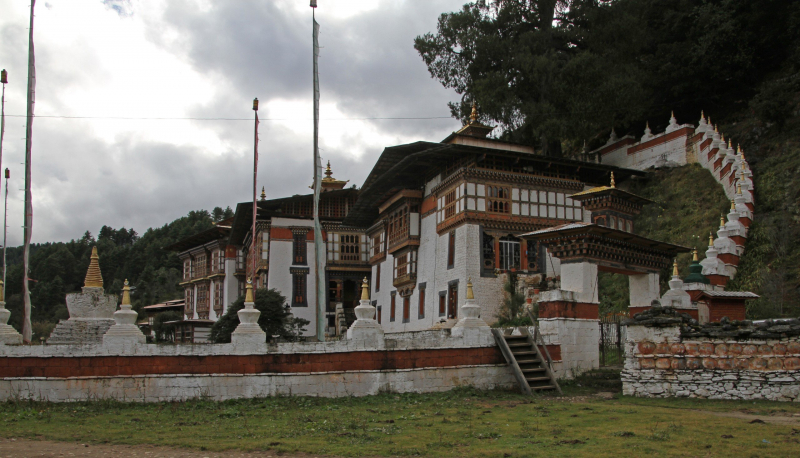
Screenshot of https://commons.wikimedia.org/wiki/File:Bumthang-Kurjey_Lhakhang-08-2015-gje.jpg Video by WildFilmsIndia -
Tamshing Lhakhang, a renowned Buddhist temple in Bhutan, boasts a distinctive architectural style and several outstanding features. This sacred site is a masterpiece of Bhutanese craftsmanship and devotion.
The temple's most striking feature is its traditional Bhutanese architectural design. It is constructed using local materials, including timber and stone, which blend seamlessly with the natural surroundings. The building's intricate woodwork is a testament to the skill and artistry of Bhutanese artisans, with finely detailed carvings adorning the doors, windows, and pillars. The dark red and white color scheme, a common motif in Bhutanese architecture, imparts a sense of serenity to the temple's exterior.
Tamshing Lhakhang's interior is equally impressive. The walls are covered in a symphony of vibrant frescoes that greet you as soon as you walk in. These murals feature scenes from the life of Bhutan's patron saint, Guru Rinpoche. These murals are not only aesthetically pleasing but also serve as a means to convey religious teachings and stories to worshippers.
One of the unique features of Tamshing Lhakhang is the central statue of Guru Rinpoche, also known as Padmasambhava. This statue is considered an important religious artifact and holds a special place in the hearts of the local community. Devotees visit the temple to offer prayers and seek blessings from this revered figure.
Another notable element is the temple's assembly hall, where religious ceremonies and rituals take place. The hall is adorned with ornate altars, offering a sacred space for meditation and prayer. The chanting of mantras and the sound of bells and drums create an atmosphere of profound spirituality.
Surrounding Tamshing Lhakhang, you'll find a peaceful courtyard and a beautiful garden. The tranquility of the surroundings enhances the spiritual experience for those who visit. The temple's location near the Tang Valley also provides stunning views of the Himalayan landscape, making it a place of serenity and natural beauty.
Address: HPQQ+246, Jakar, Bhutan
Opening hours: 06:00–18:00
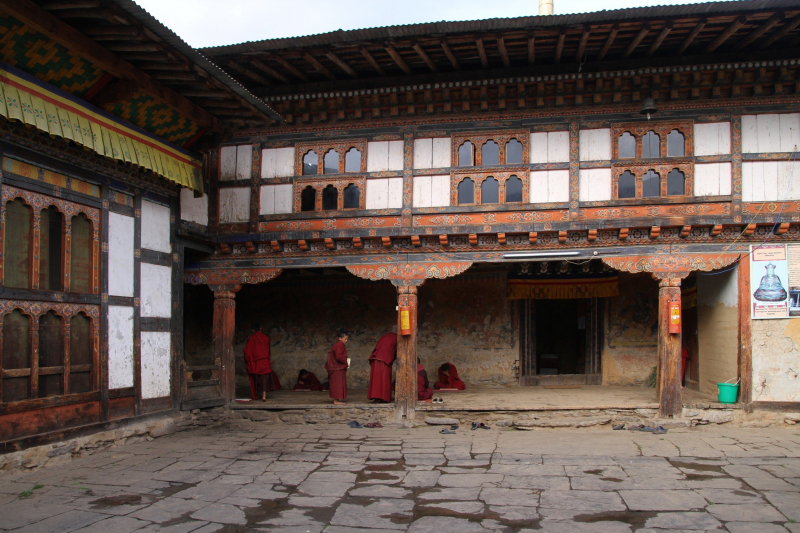
Screenshot of https://commons.wikimedia.org/wiki/File:Bumthang-Tamshing_Lhakhang-10-Innenhof-Moenche-2015-gje.jpg Video by Tshering Yangchen -
The terrain surrounding Gangteng Monastery is exceptionally beautiful. It is situated in the Phobjikha Valley, a picturesque and serene location in the Wangdue Phodrang district of Bhutan. The valley is nestled amid the Black Mountains, creating a stunning natural backdrop for the monastery.
The first striking feature of the terrain is the lush and fertile valley itself. Phobjikha Valley is renowned for its wide-open plains, pristine meadows, and verdant landscapes. These rolling hills are carpeted with vibrant fields and pristine forests, making them an ideal location for Gangteng Monastery. The valley's status as a black-necked crane conservation area and its comparatively pristine surroundings only serve to accentuate its natural beauty.
The Black Mountains, part of the Himalayan range, provide a majestic and rugged framework for the valley. These mountains are often shrouded in mist and dotted with ancient forests, creating a dramatic contrast to the peaceful valley below. The mountains are home to diverse flora and fauna, contributing to the valley's rich biodiversity.
The crystal-clear waters of the Nakay Chhu river meander through the valley, enhancing the landscape's beauty. The river not only adds to the visual appeal but also provides a valuable resource for the monastery and the local communities, supporting agriculture and sustaining life in the region.
The valley is known for its seasonal changes, with distinct beauty in both winter and summer. In winter, the valley is covered in a blanket of snow, creating a serene and enchanting winter wonderland. In contrast, the summer brings a burst of color as the valley blossoms with various wildflowers and lush vegetation.
Overall, the terrain of Gangteng Monastery in the Phobjikha Valley is a testament to Bhutan's natural splendor. The combination of fertile plains, dramatic mountains, pristine rivers, and seasonal variations makes it a landscape of exceptional beauty, making it a truly remarkable and awe-inspiring setting for the monastery.
Address: F5M7+WV9 Phobjikha Valley, Nubding, Bhutan
Opening hours: 08:00–17:00
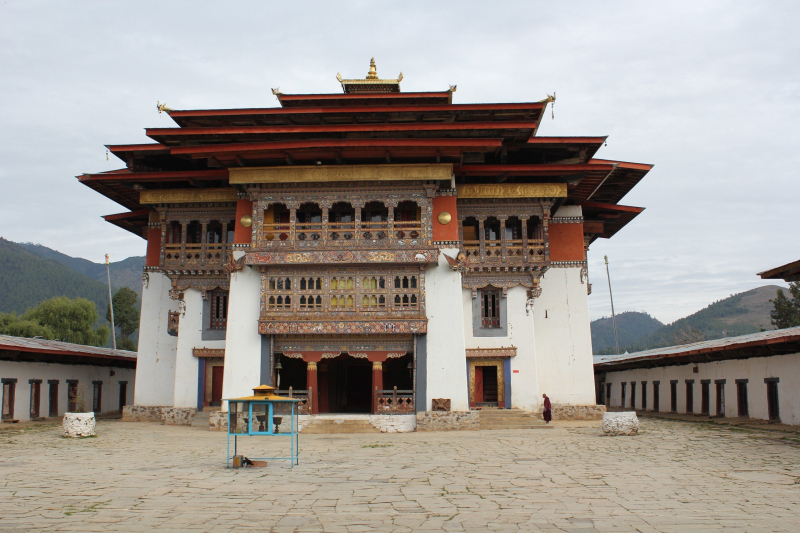
Screenshot of https://commons.wikimedia.org/wiki/File:Phobjikha_Valley,_Gangteng_Monastery_%2815843416102%29.jpg Video by Journey with Suzn -
Punakha Dzong, also known as Pungthang Dewa Chenpoi Phodrang (the Palace of Great Happiness), is the next most famous Buddhist temple in Bhutan. It is a prominent cultural and architectural gem in Bhutan. This historic fortress-monastery, situated at the confluence of the Pho Chhu (Father River) and Mo Chhu (Mother River) rivers, boasts several typical cultural features that make it a significant site in Bhutanese heritage.
One key characteristic of Punakha Dzong is its architectural style. It exemplifies traditional Bhutanese fortress architecture with its whitewashed walls, intricately carved wooden windows, and sloping roofs. The dzong's design is adorned with symbolic elements, such as dragons and mandalas, reflecting Bhutan's Buddhist traditions and cultural values.
Inside Punakha Dzong, visitors will encounter beautifully decorated courtyards and temples. These areas are often used for various religious and cultural ceremonies, making the dzong a hub for both spiritual and communal gatherings. The assembly hall, or utse, is a significant part of the dzong where religious ceremonies, meetings, and dances take place, showcasing Bhutan's deep-rooted cultural practices.
One of the most iconic cultural features of Punakha Dzong is the Ngultrum Jaakey, a unique wooden bridge. This bridge is a traditional structure used to access the dzong and is built without the use of nails or iron. The Ngultrum Jaakey is not only a practical bridge but also a symbolic representation of the sacredness and strength of Bhutanese culture.
The annual Punakha Drubchen and Tsechu festivals are vital cultural events held at the dzong. These festivals celebrate Bhutanese heritage and include masked dances, religious rituals, and vibrant processions. They draw locals and tourists alike, fostering a sense of community and cultural pride.
The dzong also serves as the winter residence of the Je Khenpo, the head abbot of Bhutan, adding a spiritual dimension to its cultural significance. The presence of the Je Khenpo further highlights the monastery's pivotal role in Bhutan's religious and cultural landscape.
Address: HVJ7+V6Q, Bhutan
Opening hours: 09:00–17:00
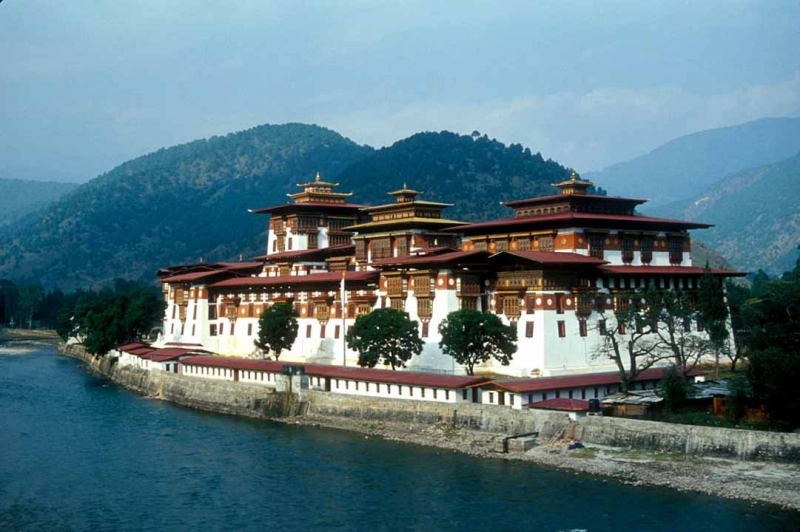
Screenshot of https://commons.wikimedia.org/wiki/File:Punakha_Dzong.jpg Video by Ram Sharan Upreti -
Ranked last in the top 10 most famous Buddhist temples in Bhutan, Tashichho Dzong, also known as the "Fortress of the Glorious Religion," is a majestic and culturally significant structure located in Thimphu, the capital of Bhutan. This impressive dzong, situated at the banks of the Wang Chhu River, serves as a symbol of Bhutan's rich cultural and religious heritage.
One of the key characteristics of Tashichho Dzong is its striking architecture. It is a prime example of Bhutanese fortress-style architecture, featuring whitewashed walls, intricately carved wooden windows, and multiple courtyards. This architectural design reflects the traditional building techniques and cultural values of Bhutan.
Tashichho Dzong houses both administrative and religious functions. The southern section serves as the administrative center for the Bhutanese government, accommodating the offices of the King, government ministers, and various government agencies. The dzong also houses the National Assembly, where important legislative matters are discussed and debated.
In addition to its administrative role, Tashichho Dzong is a vital religious center. It is home to several temples and shrines, including the main temple, which is dedicated to the protective deity Palden Lhamo. The dzong also hosts a monastic body of monks who engage in religious practices, rituals, and ceremonies.
One of the most noteworthy features of Tashichho Dzong is its role as the main venue for the annual Thimphu Tsechu, a vibrant religious festival. During this festival, monks perform intricate mask dances, and the local community gathers to celebrate Bhutanese culture and heritage. The Thimphu Tsechu is a colorful and spiritually significant event that draws both locals and visitors.
Tashichho Dzong's location along the Wang Chhu River and its serene surroundings add to its cultural charm. The picturesque setting, with lush gardens and meticulously maintained courtyards, creates a peaceful and spiritual atmosphere for those who visit. Tashichho Dzong stands as a testament to Bhutan's cultural identity and its harmonious blend of administrative and religious functions.
Address: Thim-bu, Bhutan
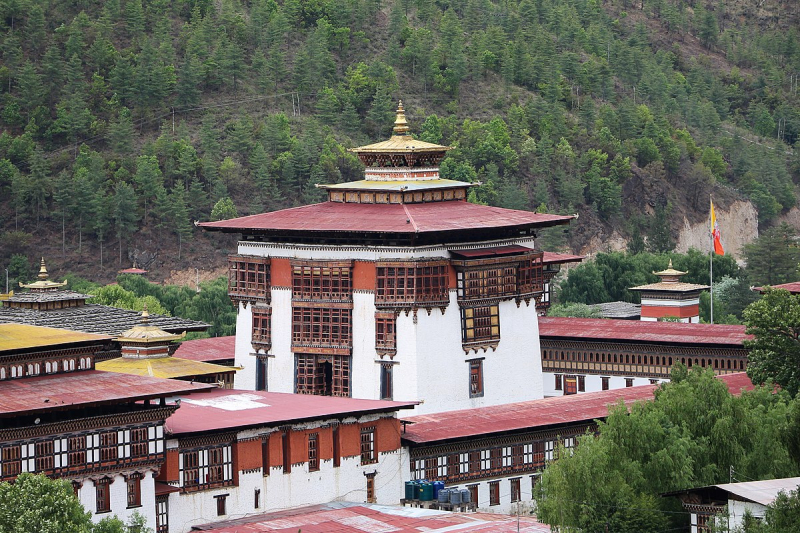
Screenshot of https://commons.wikimedia.org/wiki/File:Tashichho_Dzong,_Bhutan_03.jpg Video by Imran Hossain Bhuiyan











